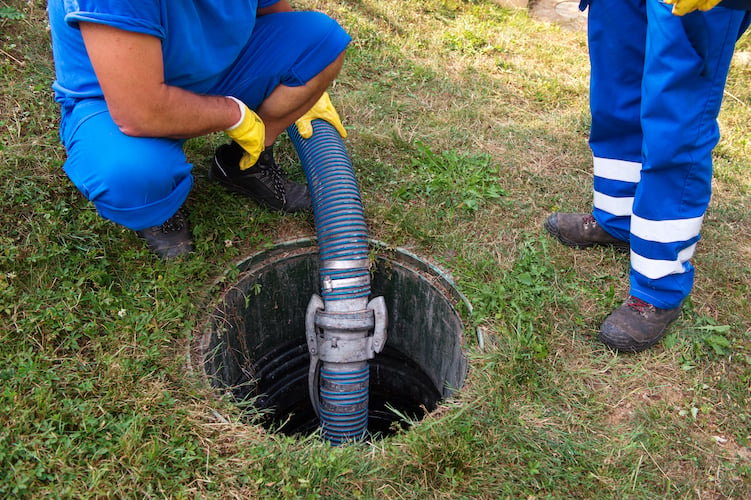Septic Cleaning
All septic systems require regular tank cleaning! The recommended cleaning frequency is 1 to 3 years, depending on household water use. A family of six is going to create three times as much wastewater as a family of two, increasing the importance of more frequent cleanings. The cleaning frequency is greatly dependent on the volume of wastewater being pushed into your septic system (big family = more frequent cleanings). We would be happy to help evaluate your situation and proper cleaning frequency. As well, we can help set you up on a regular and/or automatic cleaning schedule.
We’ve all heard “that guy” talk about how they’ve lived in their home for the past 20 years and never cleaned their tank with no problems. This is the equivalent of him saying he has owned his vehicle for the past 2 years and never changed his oil. It may be running now… but a day is coming he will have wished he did some regular maintenance. Request a quote for septic tank pumping and cleaning.

Why do I need to clean my septic tank every three years?
Regularly pumping and inspecting your septic system can help to keep your onsite wastewater system running longer, avoid costly repairs and protect water quality.
Michigan is home to more than 1.3 million onsite wastewater treatment systems. Most are for single-family homes that include a septic system. Indeed, the onsite wastewater treatment system including a septic tank and soil absorption field is the most common domestic wastewater treatment system in rural homes in the United States. In Michigan, it is estimated that 10 percent of these systems are in some level of malfunction or have failed.
Malfunctioning and failed onsite wastewater systems make our ground and surface waters susceptible to fecal contamination. Several rivers in the Lower Peninsula have been tested during low-flow conditions and were found to contain genetic markers indicating the presence of human fecal matter. This contamination can come from leaky septic systems. Keeping septic systems in good repair can protect Michigan’s water quality.
Rural homes in Michigan include onsite wastewater systems that require regular maintenance. Maintenance and inspection of your system depend upon its size, the number of people that live in the home, and what county you live in. Michigan is the last state to still adopt uniform onsite wastewater regulations. Lack of uniform statewide laws leaves regulation and inspection laws up to local officials through county health departments and districts. This means that rules for onside wastewater system laws vary between counties.
Most counties have a sale transfer ordinance requiring septic tank inspections but few have the same or similar size and installation regulations. Most ordinances cite the average of pumping and inspecting recommendation of every three years for a family of four. Many also require inspection of newly installed systems. None return a year or two later to ensure that the system is functioning properly.
An onsite wastewater system typically consists of three basic parts:
- The drain waste pipes from the house into a septic tank;
- The septic or settling tank, sometimes divided in half with a baffle; and
- Soil absorption or drain field.
Wastewater flows from the toilets, laundry, and sinks in the home through the drain pipes to the septic tank. The septic tank, made of solid cast concrete (in most cases) has an inlet and an outlet for effluent. Once the waste enters the tank the solids settle to the bottom to decompose and become the sludge layer. Effluent water is in the middle and the lighter grease and soaps float to the top to create the scum layer. The effluent water flows out through a pipe to the drain field. Newer tanks sometimes contain a baffle creating a second settling area before water is released to the soil absorption field. Michigan State University Extension’s webpage on Septic systems gives more detail on this topic.
If the sludge is not pumped out on a regular basis then the layer gets thick allowing solids to flow into the drain field. This plugs and compacts in the drain tiles and the soil causing failure. Many times people think that this is a sign that the septic is full, and indeed it is but it is also a failure. Drain field failure requires soil removal and replacement and can become an expensive repair. This is one of the most common failures. Other common causes of septic failure include tanks collapsing from being driven or parked on; tree roots; excessive water from parties or heavy rains; pipes clogged from flushing items other than toilet paper such as feminine products and personal sanitary wipes; biological processes stopped from overuse of chlorine or antibiotic soaps.
 If you are experiencing sewage waste back up into your house from your septic tank this may indicate a total blockage of the tank and drain field and could indicate a costly repair or replacement. Regular inspections and pumping can prevent expensive repairs later. Just as it is recommended to regularly inspect our cars and furnaces, we should also inspect and clean out our onsite wastewater systems. The average recommendation is every three years for a typical family home with three bedrooms equipped with a 1000 gallon tank. It’s important to know the size of your septic tank.
If you are experiencing sewage waste back up into your house from your septic tank this may indicate a total blockage of the tank and drain field and could indicate a costly repair or replacement. Regular inspections and pumping can prevent expensive repairs later. Just as it is recommended to regularly inspect our cars and furnaces, we should also inspect and clean out our onsite wastewater systems. The average recommendation is every three years for a typical family home with three bedrooms equipped with a 1000 gallon tank. It’s important to know the size of your septic tank.
Older homes may have smaller tanks. Smaller tanks need to be pumped more often. For example, if a three-bedroom home has a 900-gallon septic tank with six people living there, they should schedule their pumping for everyone and one-half to two years to avoid failure. If a home uses a garbage disposal consider that they are increasing the amount of solids (pre-digestion) going into the tank. This home will require more frequent pumping.
Concrete, plastic, and fiberglass tanks are not infallible, lots of things can cause the material to fail resulting in collapse. Inspectors look at the integrity of your system. Fractures caused by frost/freeze break up, ground heaves, earthquakes, manufacturer defects, burrowing animals, and tree roots all have an impact on our systems. Michigan DEQ does have a guide on subsurface onsite wastewater treatment systems but its recommendations are not enforceable by law. Michigan County Environmental Health departments have laws, consult your County for its recommendations for onsite wastewater system maintenance.
Regular maintenance can help prevent system failure
The most important thing to understand regarding your septic tank system is that you don’t just pump the tank once it “fills up”. A septic tank is designed to function “full”. The average septic tank is 1000 gallons. The average household uses 1000 gallons of water each week. This means it takes only a week for a tank to fill back up after a cleaning! The difference is all the solid waste and “sludge” that built up over the previous 2 years was removed when the tank was pumped, filling back up with 99% water. This is the actual point of “pumping” the tank. The longer you allow the solid waste and sludge to build up in your tank, the greater risk you run of that material finding its way out of your tank and into your drain field. Solid waste and sludge take no time at all to destroy a drain field once that material begins to plug up the drainage system (perforated pipe/stone/sand). The damage this causes is permanent and irreversible. It will eventually lead to total field failure and require a complete septic field replacement. The easiest and most affordable way to extend the life of your septic system is to make sure only the “cleanest” water possible is going into your septic field. That is best accomplished through regular septic tank cleanings.
When you schedule your tank cleaning with Al Pearson & Son Septic Tank cleaning, we make sure to answer all your questions and address any concerns up front. We take extreme care to treat your yard, landscaping & driveway as if it were our own. We will meet you at your home and explain the septic cleaning process at the time of service (if interested). If you’d prefer we handle it 100% while you’re at work… we can explain the process over the phone and take care of it while you’re out. Either way, our goal is to make cleaning your septic tank as easy and painless as possible.
Give us a Call!
If you are experiencing issues with your septic system give us a call. We can quickly diagnose the issue and provide you with a repair plan.

